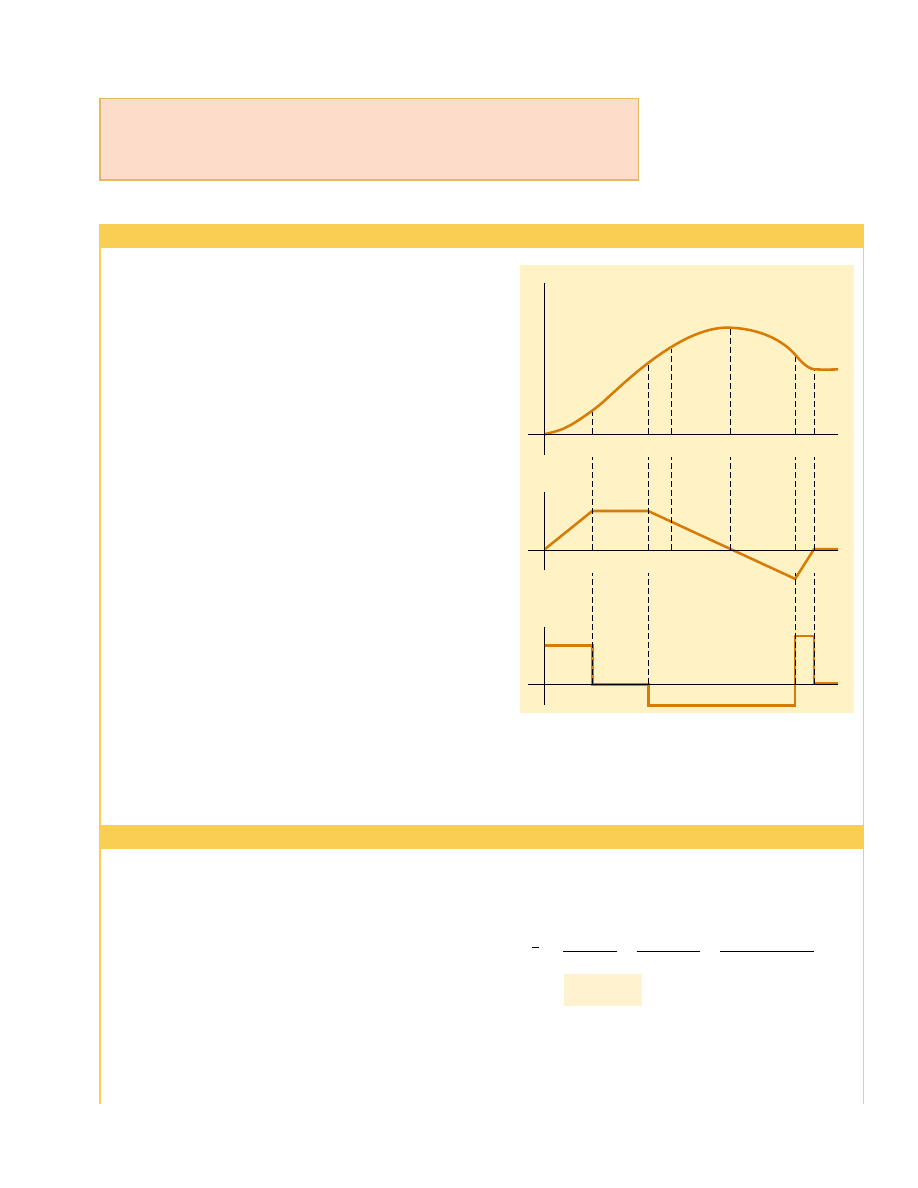Physics For Scientists And Engineers 6E - part 9

S E C T I O N 2 . 3 • Acceleration
33
Conceptual Example 2.4 Graphical Relationships between x, v
x
, and a
x
(a)
(b)
(c)
x
t
F
t
E
t
D
t
C
t
B
t
A
t
F
t
E
t
D
t
C
t
B
t
t
A
O
t
O
t
O
t
F
t
E
t
B
t
A
v
x
a
x
Figure 2.7 (Example 2.4) (a) Position–time graph for an ob-
ject moving along the x axis. (b) The velocity–time graph for
the object is obtained by measuring the slope of the
position–time graph at each instant. (c) The acceleration–time
graph for the object is obtained by measuring the slope of the
velocity–time graph at each instant.
The position of an object moving along the x axis varies with
time as in Figure 2.7a. Graph the velocity versus time and
the acceleration versus time for the object.
Solution The velocity at any instant is the slope of the
tangent to the x -t graph at that instant. Between t ! 0 and
t ! t
A
, the slope of the x -t graph increases uniformly, and
so the velocity increases linearly, as shown in Figure 2.7b.
Between t
A
and t
B
, the slope of the x -t graph is constant,
and so the velocity remains constant. At t
D
, the slope of
the x -t graph is zero, so the velocity is zero at that instant.
Between t
D
and t
E
, the slope of the x -t graph and thus the
velocity are negative and decrease uniformly in this inter-
val. In the interval t
E
to t
F
, the slope of the x-t graph is still
negative, and at t
F
it goes to zero. Finally, after t
F
, the
slope of the x -t graph is zero, meaning that the object is at
rest for t & t
F
.
The acceleration at any instant is the slope of the tan-
gent to the v
x
-t graph at that instant. The graph of accelera-
tion versus time for this object is shown in Figure 2.7c. The
acceleration is constant and positive between 0 and t
A
,
where the slope of the v
x
-t graph is positive. It is zero be-
tween t
A
and t
B
and for t & t
F
because the slope of the v
x
-t
graph is zero at these times. It is negative between t
B
and t
E
because the slope of the v
x
-t graph is negative during this
interval.
Note that the sudden changes in acceleration shown in
Figure 2.7c are unphysical. Such instantaneous changes can-
not occur in reality.
Quick Quiz 2.3
Make a velocity–time graph for the car in Figure 2.1a. The
speed limit posted on the road sign is 30 km/h. True or false? The car exceeds the
speed limit at some time within the interval.
Therefore, the average acceleration in the specified time in-
terval $t ! t
B
#
t
A
!
2.0 s is
The negative sign is consistent with our expectations—
namely, that the average acceleration, which is represented
by the slope of the line joining the initial and final points
on the velocity–time graph, is negative.
(B)
Determine the acceleration at t ! 2.0 s.
#
10 m/s
2
!
a
x
!
v
xf
#
v
xi
t
f
#
t
i
!
v
x
B
#
v
x
A
t
B
#
t
A
!
(20 # 40) m/s
(2.0 # 0) s
v
x
B
!
(40 # 5t
B
2
) m/s ! [40 # 5(2.0)
2
] m/s ! % 20 m/s
The velocity of a particle moving along the x axis varies in
time according to the expression v
x
!
(40 # 5t
2
) m/s,
where t is in seconds.
(A)
Find the average acceleration in the time interval t ! 0
to t ! 2.0 s.
Solution Figure 2.8 is a v
x
-t graph that was created from
the velocity versus time expression given in the problem
statement. Because the slope of the entire v
x
-t curve is nega-
tive, we expect the acceleration to be negative.
We find the velocities at t
i
!
t
A
!
0 and t
f
!
t
B
!
2.0 s
by substituting these values of t into the expression for the
velocity:
v
x
A
!
(40 # 5t
A
2
) m/s ! [40 # 5(0)
2
] m/s ! % 40 m/s
Example 2.5 Average and Instantaneous Acceleration